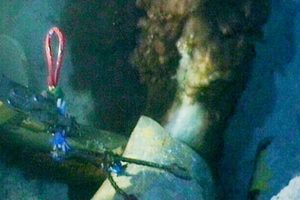
BP Is Capturing Some Of Crude Gushing Into Gulf Coast. BP finally has a containment dome over the Deepwater Horizon oil well, and says it is capturing some of the crude gushing into the Gulf of Mexico. However, the company can’t say right now exactly how much oil is being captured. On the live video feed […]

BP Is Capturing Some Of Crude Gushing Into Gulf Coast. BP finally has a containment dome over the Deepwater Horizon oil well, and says it is capturing some of the crude gushing into the Gulf of Mexico. However, the company can’t say right now exactly how much oil is being captured. On the live video feed of the well, it did not appear that the oil spewing out had been reduced by very much.
BP is optimistic that its latest attempt at containing the Deepwater Horizon oil spill will work. On the NBC Today Show this morning, BP Chief Operating Officer Doug Suttles said that oil was flowing from the containment dome up a pipe that will take it to a tanker on the surface.
Suttles said he thought it was possible that the system could capture 90 percent of the flow. Engineers would have more information about the amount of oil being captured later today, he said.
This is not the first time BP has tried to cap the leaking well, which is located about 5,000 feet below the surface of the ocean. Last month, it failed at deploying another dome system when the deep ocean’s freezing temperatures caused a build up of ice crystals. This time, BP is pumping methanol to try to prevent that.
The Deepwater Horizon oil spill began on April 20, when the oil rig exploded, killing 11 crew. Since then, the gushing well has been spewing as much as 800,000 gallons of oil per day into the Gulf of Mexico. It has already surpassed the Exxon Valdez disaster, and ranks as the worst oil spill in U.S. history.
So far, all of BP’s attempts to stop the leaking have failed. There is no guarantee this latest try will work either, and even if it does, it is not expected to contain all of the oil spewing into the Gulf. There is even a chance it could worsen the situation, and increase the flow by as much as 20 percent.
The oil leak won’t be permanently stopped until BP completes one of two relief wells it is drilling nearby. The earliest that will occur is mid-August.
Even if the new containment system works, BP still faces huge clean up costs because of the spill, which continues to move northeast, threatening Mississippi, Alabama and Florida. Already, over 100 miles of Louisiana coastline, with its vital marshes and wetlands, has been polluted by thick crude. According to The Wall Street Journal, President Barack Obama has already sent the company the first bill, for $69 million, for services rendered by the federal government in the spill response.
Concerns about the oil impacting the east coast of the U.S. and the Atlantic Ocean are also growing. Yesterday, scientists from the National Center for Atmospheric Research (NCAR) said their computer modeling showed the slick reaching Florida’s Atlantic coast within weeks if it makes it into Gulf Loop Current.
It could then move north as far as about Cape Hatteras, North Carolina, with the Gulf Stream, before turning east. Once the oil is in the Loop Current, it will travel about 40 miles per day. In the Atlantic’s Gulf Stream, it can travel about 100 miles per day, NCAR said.
There are also worries that hurricane season, which started earlier this week, could complicate the containment and cleanup efforts. According to The Wall Street Journal, BP CEO Tony Hayward has said the company is hoping to introduce a new containment system at the end of this month that will be “be better able to deal with hurricanes should they arrive.”
The personal injury attorneys at Parker Waichman LLP offer free, no-obligation case evaluations. For more information, fill out our online contact form or call 1-800-YOURLAWYER (1-800-968-7529).
Our Explosion accident lawyers are here to help you when you need it the most.


